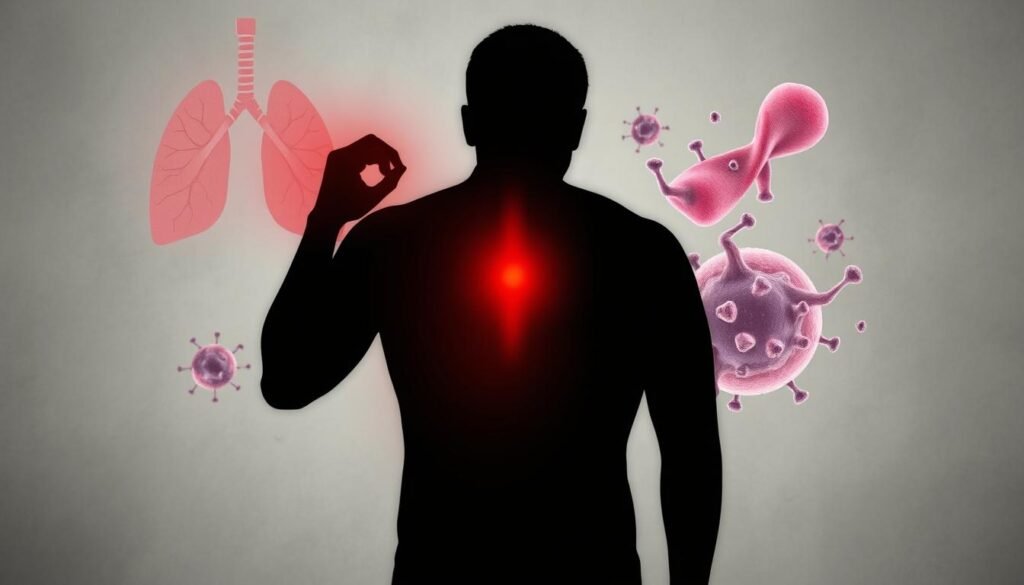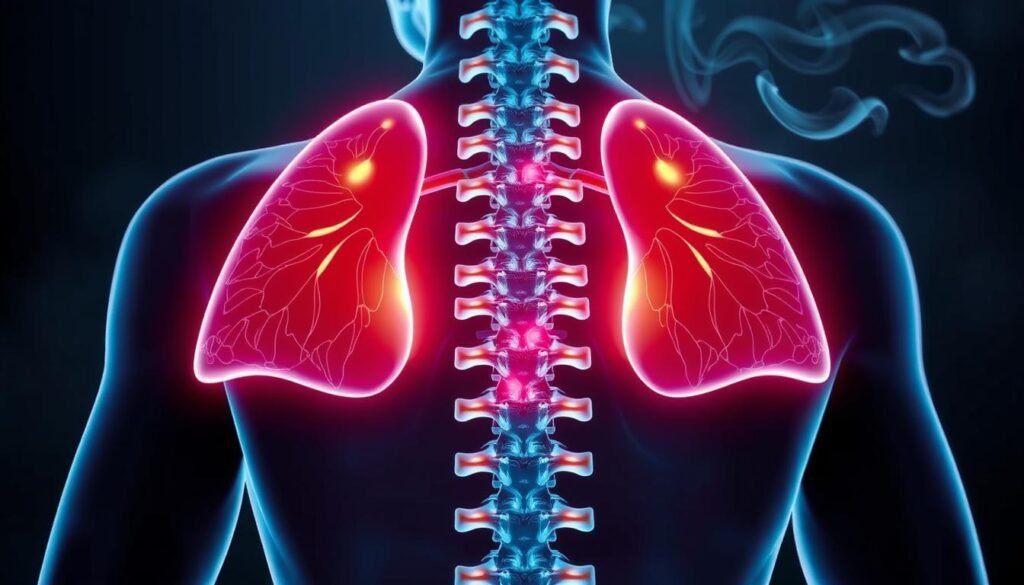About 25 percent of people with lung cancer feel back pain as an early sign. This pain is not just ordinary; it’s a clue. It can hint at something serious like lung cancer, especially for those with a smoking history or who’ve been around secondhand smoke. Knowing when to seek medical advice for back pain and lung cancer is vital. It can change how well treatments work if caught early.
Back pain can come from many sources, but don’t ignore it. It’s especially true if it comes with other worrying signs. Pancoast tumors, a cancer type, cause pain near the shoulder blades and other specific symptoms. To understand how back pain links to lung cancer, you can read more at this resource. Or, to learn about shoulder-related lung cancer signs, check out this link.
Key Takeaways
- About 25 percent of lung cancer patients experience back pain.
- Recognizing unusual back pain symptoms is crucial for early detection.
- Risk factors include a history of tobacco use and exposure to secondhand smoke.
- Other concerning symptoms may accompany back pain and warrant immediate medical attention.
- Timely medical consultation can lead to better treatment outcomes.
Understanding Back Pain: Common Causes
Back pain can affect people no matter their age or background. It often comes from many common causes. Muscle strains might happen from lifting wrong or moving suddenly. These often lead to feeling uncomfortable. Spinal injuries can come from accidents or falling. They hurt the back’s structure and can cause ongoing pain. Conditions like degenerative disc disease and arthritis are common in older folks. They add to the lasting discomfort.
Experts say age, how active you are, and your job can make back pain more likely. A study showed about 39% of adults deal with back pain each year. This shows it’s a widespread issue.
It’s important to pay attention to any back pain that doesn’t go away. Even if most causes aren’t serious, some pains can point to bigger problems. If symptoms stay or can’t be explained, seeing a doctor is a smart move.
| Common Causes of Back Pain | Description | Potential Risk Factors |
|---|---|---|
| Muscle Strains | Caused by improper lifting or sudden movements. | Age, poor physical conditioning. |
| Spinal Injuries | Results from accidents or falls affecting spinal alignment. | High-impact sports, workplace accidents. |
| Degenerative Disc Disease | Wear and tear on spinal discs leading to pain. | Older age, family history. |
| Arthritis | Involves inflammation of joints, contributing to pain. | Age, genetic predisposition. |
Knowing these facts helps people spot problems early on. Understanding back pain can lead to finding good ways to deal with it. This can make life better.
Back Pain Symptoms to Watch For
Back pain symptoms vary, needing careful observation. A key sign is persistent back pain that gets worse at night or while resting. Such discomfort may hint at serious health issues, including lung cancer risks.
If back pain spreads down the legs, it’s important to take note. It might suggest spinal problems or nerve involvement. Other warning signs include unexplained weight loss, breathing difficulties, or constant coughing. These symptoms call for quick medical help.
The link between back pain and lung cancer raises concerns. Initial symptoms of lung cancer may feel like back pain. About 1 in 4 people with lung cancer have reported back pain. Thus, ongoing back pain might flag early lung cancer signs.
Early detection of severe conditions is crucial. Below is a table of back pain symptoms tied to different health issues:
| Symptom | Possible Condition | Action Needed |
|---|---|---|
| Pain worsening at night | Potential malignancy or infection | Seek immediate medical attention |
| Pain radiating down the legs | Spinal nerve compression | Consult a healthcare provider |
| Unexplained weight loss | Various serious conditions | Schedule a check-up |
| Sudden numbness or weakness | Possible spinal cord involvement | Emergency evaluation required |
| Pain that doesn’t improve with treatment | Chronic or serious conditions | Reassess treatment with a doctor |
Knowing these symptoms and their possible meanings can help. It may lead to early detection and better chances in fighting serious conditions, like lung cancer.
Lung Cancer Signs: What to Look For
Lung cancer is the second most common cancer in the United States. It’s important to know the signs of lung cancer. They often go unnoticed until the cancer has developed further. Finding these signs early is key to getting the right help.
A persistent cough is a major sign of lung cancer. If you’ve been coughing for more than eight weeks, it could be a sign. This is especially true if you cough up blood. If you see these signs and you smoke or are around smoke a lot, see a doctor soon.
Some other signs include losing weight without trying and feeling very tired. If you suddenly feel different or can’t catch your breath, pay attention. Chest pain or tightness can also be a sign. This happens when tumors press on nerves.
Knowing these signs can help you talk to your doctor early. If you are 55 to 80 years old or used to smoke, think about getting screened regularly. For more info on lung cancer signs, you might find this article helpful.
It’s really important to be aware of lung cancer signs. This awareness can help find the cancer earlier. This makes treatment more likely to succeed, which can save lives.
The Connection Between Back Pain and Lung Cancer
Knowing how back pain and lung cancer are linked is key for catching it early. Studies show that back pain can be a major sign for those with lung cancer. Before being diagnosed, about 25% of lung cancer patients feel back pain.
This pain usually starts when the cancer spreads to the spine or nearby places. When cancer moves to other parts, it can cause bone pain, squeeze the spinal cord, or even break bones. In those with non-small cell lung cancer, bones are affected in 30% to 40% of them. The cancer pushes against nerves in the spine, leading to radiculopathy. This condition results in back pain and other nerve problems, worsening the patient’s life.
Sometimes, back pain comes from problems caused or made worse by lung cancer treatment. Conditions like pneumothorax, pulmonary embolism, and pleurisy can make sharp or ongoing pain that spreads to the back. Understanding that back pain can mean lung cancer is crucial for getting help early.

| Type of Relationship | Description | Incidence (% of cases) |
|---|---|---|
| Bone Metastasis | Involvement of bones causing pain and potential complications. | 30% – 40% |
| Leptomeningeal Metastasis | Spread to the meninges, affecting nerve function. | 1% – 5% |
| Radiculopathy | Nerve root compression leading to pain symptoms. | Variable |
| Back Pain | Reported in patients as a key warning sign. | 25% |
When to Seek Medical Advice for Back Pain and Lung Cancer
Knowing when to get medical help for back pain is crucial. Some symptoms suggest the need for urgent care. This is for a quick treatment and a better chance of getting well.
Key Symptoms Indicating Urgent Care
Be on the lookout for these important signs. They mean you should see a doctor right away:
- Sudden onset of severe back pain
- Back pain accompanied by neurological signs like numbness or weakness
- Pain that persists despite usual treatments
- Significant changes in weight or appetite
- Chronic fatigue, particularly when unexplained
Red Flags Associated with Lung Cancer
Certain signs should alert you to the possibility of lung cancer. These require quick action:
- Persistent cough that does not improve
- Coughing up blood or rust-colored sputum
- Chest pain that worsens with specific movements or deep breaths
- Shortness of breath unrelated to other conditions
- Unexplained weight loss or loss of appetite
- Fatigue that seems disproportionate to activity levels
- Recurrence of respiratory infections, like pneumonia or bronchitis
If you have back pain or signs listed here, don’t wait. Recognizing these early can make a huge difference for conditions like lung cancer. It makes sure you get the help you need quickly.
How Lung Cancer Affects the Spine
Lung cancer can greatly affect different parts of the body, especially the spine. It often spreads to the spine, causing back pain. This pain can be dull or sharp, depending on how much the spine is involved.
Spinal Metastasis and Back Pain
About 19% of people with lung cancer will experience spinal metastasis. This means tumors grow in the spine and press on nerves. This pressure causes pain that can spread across the back. Therefore, it shows how lung cancer can affect the spine directly.
Spinal metastasis can bring serious health issues. It’s important to get checked by a doctor and treated right away.
Potential Symptoms of Malignant Spinal Cord Compression
When lung cancer reaches the spine, it can press on the spinal cord. This can cause very bad back pain, weak legs, and even problems with bowel or bladder control. Knowing these symptoms is key to get help fast.
If someone has these signs, they should seek medical help quickly. Doing so can stop more severe problems. Knowing about lung cancer and these symptoms helps people take action early.
For more information on how lung cancer and back pain are connected, you can check out this article. It talks about how important it is to diagnose and manage these signs early.

Diagnosing Back Pain Related to Lung Cancer
Diagnosing back pain related to lung cancer starts with looking at your medical history. A full physical exam is also key. This is especially crucial for those with a high risk of lung cancer.
Doctors use various tests to check for lung cancer. X-rays, CT scans, and MRIs help see if back pain and lung cancer are connected. For example, heavy smokers over 50 might get a low-dose CT scan every year. This helps find lung cancer early.
If the first tests show something unusual, more tests like PET scans or biopsies might be needed. Biopsies can confirm if there’s cancer. They may check your blood too. High calcium levels can show problems like cancer spreading to the spine.
Here’s a summary of the diagnostic tests commonly used in evaluating back pain related to lung cancer:
| Diagnostic Test | Purpose |
|---|---|
| X-rays | Initial imaging to detect abnormalities in the spine and lungs. |
| CT Scans | Detailed imaging to assess lung tissues and surrounding structures. |
| MRIs | Visualization of soft tissues to check for spinal involvement. |
| PET Scans | Detecting metabolic activity of cancer cells in the body. |
| Biopsies | Confirmatory tests to analyze tissue samples for cancerous cells. |
| Blood Tests | Measurement of calcium levels and other markers associated with cancer. |
Diagnosing back pain related to lung cancer has many steps. The goal for doctors is to find out the real cause of the pain quickly. Catching it early and figuring out the right diagnosis is key. This way, patients get the care they need right away.
Treatment Options for Back Pain and Lung Cancer
Dealing with back pain from lung cancer takes a special plan. This ensures comfort and a better life quality. Different treatments focus on easing pain while tackling lung cancer’s root causes.
Medications for Pain Relief
A variety of medications help with lung cancer’s back pain. Things like acetaminophen or NSAIDs, such as ibuprofen, are common first steps. For worse pain, doctors might prescribe stronger drugs like morphine or oxycodone. Medicines like anticonvulsants and antidepressants can also help with ongoing pain issues.
Therapies to Manage Back Pain
Therapies are crucial besides medicines for lung cancer back pain. Physical therapy strengthens back muscles, enhancing movement and lessening pain. Treatments like acupuncture, massage, and yoga also improve comfort and reduce pain. Palliative care provides support aimed at elevating life quality for those confronting these issues.

Living with Back Pain: Lifestyle Modifications
Many people with back pain from cancer, especially lung cancer, can get better by changing their lifestyle. Regular exercise that fits your abilities can make muscles stronger and increase movement. Activities like walking or gentle stretching can help your back feel better.
It’s important to keep a healthy weight to reduce back strain. Eating well helps your overall health and manages back pain symptoms. Being overweight can put more stress on your back, making pain worse.
Using your body the right way is key to avoiding and easing back pain. This means lifting objects with your legs instead of your back. Making your home and work spots more back-friendly can also help. Things like sitting in good chairs and using lumbar rolls while driving make a big difference.
Relaxation methods like deep breathing, yoga, or mindfulness can lower stress and pain. Many studies say these methods are good for people with lung cancer. They help you stay calm and might make your life better.
The table below shows how certain changes can help with back pain. These changes are also good for people dealing with lung cancer:
| Modification | Description | Benefits |
|---|---|---|
| Regular Exercise | Engage in low-impact activities like walking or swimming. | Strengthens muscles, improves flexibility, and enhances mood. |
| Healthy Diet | Consume a balanced diet rich in fruits, vegetables, and lean proteins. | Supports weight management and overall health. |
| Proper Body Mechanics | Use correct lifting techniques and ergonomic tools. | Reduces the risk of strain or injury to the back. |
| Relaxation Techniques | Practice yoga, meditation, or deep breathing exercises. | Alleviates stress and tension, potentially reducing pain. |
Adding these lifestyle changes can better the lives of those with chronic back pain. It lets them enjoy life more, even with lung cancer.
Conclusion
Understanding the link between back pain and lung cancer is key to good health. Back pain might point to serious issues like lung cancer. It’s important to note symptoms like ongoing pain, unexpected weight loss, and tiredness.
These signs might help catch lung cancer early, which is crucial. Lung cancer is common and it’s vital to know the signs. This awareness can prompt you to seek medical help on time.
Everyone should get checked if they have constant back pain or related signs due to lung cancer’s high death rates. Catching it early can make a big difference. Things like chemo, special treatments, and ways to manage pain can make people feel better and live longer.
Being informed and active about health issues, especially back pain and lung cancer, leads to better health. Talking to doctors and making healthy choices can improve your life. This is especially true when dealing with the risk of cancer.